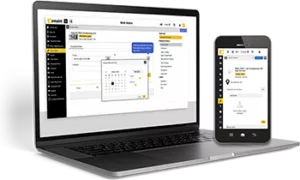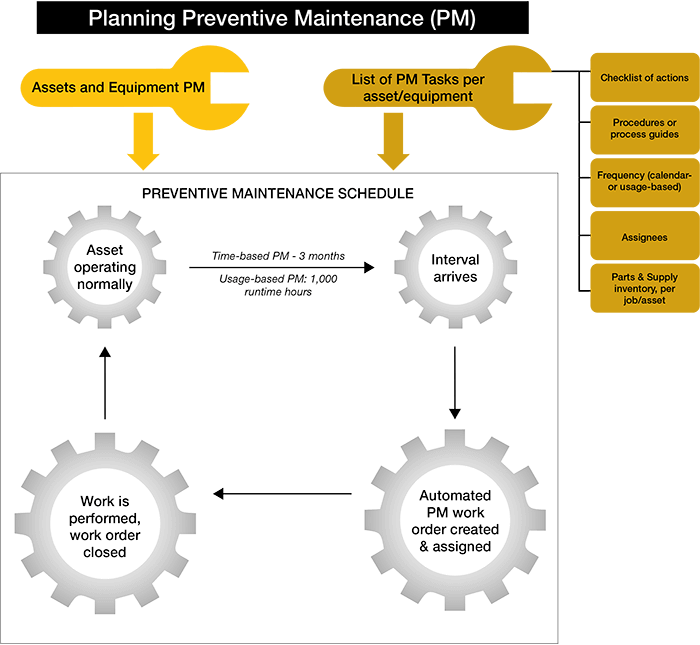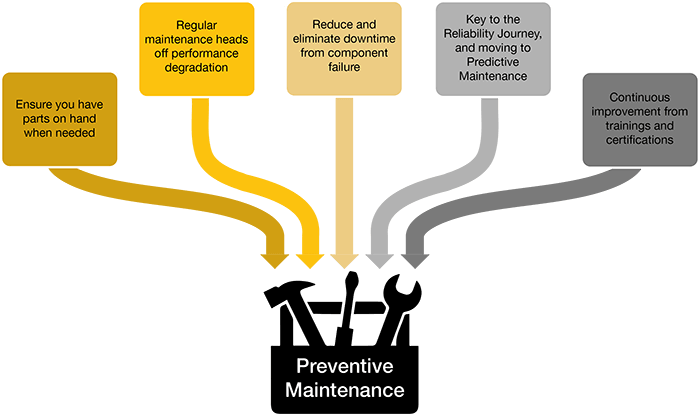What is Preventive Maintenance?
Preventive maintenance (PM) is a strategy in which maintenance work is performed ahead of time to prevent asset failures that can result in downtime, safety issues, and production shutdowns. Preventive maintenance boosts uptime, reduces costs, and simplifies labor, part, and resource planning for maintenance planners. A preventive maintenance work order, often simply known as a “PM” in the industry, may include the asset in need of work, work instructions, necessary parts, or PM checklists to ensure all tasks are completed. Preventive maintenance – standardized in the form of PM programs and PM schedules – is a powerful strategy for maximizing asset lifespan and optimizing production, labor, and resource efficiency across industrial facilities.
Preventive maintenance and preventative maintenance are synonymous: two ways of talking about the same strategy for scheduling maintenance to prevent failures and shutdowns.
Maintenance teams generally employ one of two types of preventive maintenance: calendar-based or usage-based. Calendar-based PM relies on regularly scheduled work, whereas usage-based PM is performed based on utilization datapoints like runtime.
Preventive maintenance is also performed as part of the broader family of “proactive” maintenance strategies like predictive or prescriptive maintenance, which each have distinct applications in which they are advantageous, but all focus on preventing downtime.
Preventive maintenance is a relatively straightforward strategy to establish and set in motion. Managers schedule preventive maintenance work orders based on calendar dates or usage, often at the manufacturer’s recommendation. Teams shut down equipment during the specified date and time. Then, they perform the outlined tasks on that piece of equipment.
For example, forklift manufacturers may suggest performing maintenance every 150 to 200 hours of use, establishing a time-based trigger. Using data from the forklift, the CMMS can send a notification when the forklift has reached 150 hours of use. It then provides a preventive maintenance checklist for the tasks that must be completed. Performing this maintenance can extend the life of assets, increase productivity, improve overall efficiency, and reduce maintenance costs.
Organizations can recognize cost savings by scheduling preventive maintenance during times that work best for the flow of business, such as during planned downtime. Before performing PM, all parts and maintenance resources should be on hand and accounted for to streamline the process.
Preventive maintenance does not require additional tools (other than the manufacturer’s recommendations), but it does require a team willing to adopt new maintenance processes. To achieve buy-in from the group, it is crucial to outline the benefits of a PM program and identify how a preventive maintenance schedule will make the jobs of technicians, mechanics, and engineers much more manageable.
Preventive maintenance software, including a Computerized Maintenance Management System (CMMS), can simplify preventive maintenance through features such PM work orders. Streamlining maintenance practices with a CMMS can also reduce emergency reactive work and increase worker safety and efficiency.
Types of Preventive Maintenance
Preventive maintenance is essential for most industrial machine assets, but there are several strategies that fall under the umbrella of PM. The type of preventive maintenance best employed depends on the asset, the manufacturer’s recommendations, and your use of the asset.
Preventive maintenance is traditionally understood to be either time-based (scheduled at regular intervals) or usage-based (performed based on utilization). However, proactive maintenance strategies like predictive or prescriptive maintenance also can be thought of as preventive maintenance.
Here are the main types of preventive maintenance:
1. Time-Based Maintenance (TBM):
- Scheduled at regular intervals (daily, weekly, monthly, annually), regardless of equipment condition.
- Example: Regularly scheduled oil changes, filter replacements, and inspections.
2. Usage-Based Maintenance (UBM):
- Performed based on the actual usage of the equipment, measured by metrics such as hours of operation or production cycles.
- Example: Servicing a machine after it has operated for a specified number of hours or produced a certain number of units.
3. Predictive Maintenance (PdM):
- Utilizes condition-monitoring tools and techniques to predict when maintenance should be performed based on the actual condition of the equipment.
- Example: Using vibration analysis or thermal imaging to identify wear and tear before it leads to equipment failure.
4. Prescriptive Maintenance:
- An advanced form of predictive maintenance that not only predicts when maintenance is needed but also suggests specific actions to prevent future issues.
- Example: Recommending adjustments to machine settings or operational practices based on data analysis.
Preventive Maintenance Examples
Preventive maintenance encompasses a broad range of proactive maintenance work performed on a huge diversity of assets – from tiny motor components to vast ammonia refrigeration systems. Here are some common examples of preventive maintenance across industries:
1. Manufacturing Industry:
- Example: Regularly scheduled lubrication and calibration of conveyor belts, presses, and assembly line machines. This includes checking for wear and tear, replacing worn-out parts, and ensuring machinery operates smoothly to avoid production interruptions.
2. Automotive Industry:
- Example: Routine vehicle servicing, such as oil changes, tire rotations, brake inspections, and fluid top-offs. Preventive maintenance also includes inspecting the engine, transmission, and other critical components to ensure vehicles remain reliable and safe.
3. Healthcare Sector:
- Example: Scheduled maintenance of medical devices and equipment, such as MRI machines, ventilators, and diagnostic tools. This involves calibrating equipment, updating software, and replacing parts to ensure accurate diagnostics and patient safety.
4. IT and Data Centers:
- Example: Regular maintenance of servers, cooling systems, and network infrastructure. Tasks include software updates, hardware checks, and cleaning to prevent data loss and downtime, ensuring continuous and efficient operation.
5. Construction Industry:
- Example: Routine inspections and servicing of heavy machinery like bulldozers, cranes, and excavators. Preventive tasks include hydraulic system checks, engine tune-ups, and tire inspections to prevent breakdowns that can delay projects.
What Benefits Does Preventive Maintenance Have? Advantages and Disadvantages
Preventive maintenance offers a wealth of benefits to businesses who utilize a PM strategy: preventing failures that could be disastrous to production or endanger health and safety, planning ahead to optimize labor and parts inventory, and boosting the overall reliability and lifespan of critical assets. An effective PM program helps organizations maximize production and labor efficiency while reducing costs.
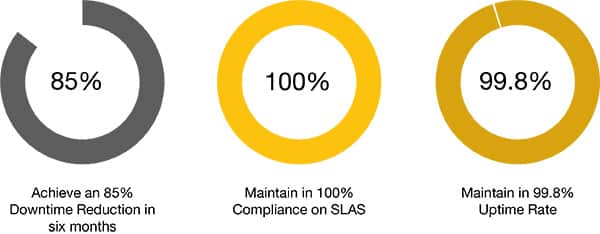
Five Advantages of Preventive Maintenance
- Increases Asset Lifespan
A major advantage of preventive maintenance is a longer asset lifespan. When assets are kept in the best possible health, their lifespan increases, reducing overall costs for the organization by avoiding unnecessary failures and replacements.
- Saves Money
Preventive maintenance gives maintenance managers the ability to optimize work schedules, plan ahead for spare parts inventory ordering, and reduce the costs of production shutdowns and asset replacement.
- Reduces Disruptions
Rather than halting production when fulfilling requests, technicians can schedule maintenance around expected downtimes to optimize equipment availability: techs can focus on assets available for work, assigning employees with matching skills, and prioritize based on criticality
- Increases Worker Safety
Preventive maintenance reduces safety issues for workers, such as fires, hazardous materials spills, or slippery walking surfaces caused by leaks. Preventive maintenance checklists and procedures can also ensure that every worker follows correct protocols, such as lock-out tag-out procedures and other safety-related measures that enhance and support worker safety.
- Reduces Equipment Downtime
Lastly, preventive maintenance minimizes overall downtime because your assets are more reliable, and your technicians can schedule planned downtime for repairs around production schedules.
Disadvantages of Preventive Maintenance
While preventive maintenance has many advantages, it won’t prevent 100% of potential failures — and it also has some disadvantages.
- Potential for Over-maintenance
One issue with performing maintenance on a planned schedule is that it may not always be needed when it’s scheduled. One example is HVAC filters. Changing a filter on a schedule may result in it being changed more often than required, which can increase costs due to both the filter replacement and the employee’s time.
- Can Be Costly to Implement
As with any sweeping organizational change, it can be expensive to implement a preventive maintenance program, as it involves work order and asset management, and meticulous scheduling. This is especially true if your organization doesn’t have CMMS software that simplifies PM scheduling.
- Requires Extensive Employee Buy-in
Successful implementation requires getting employees on board with the new processes and ensuring they understand how their work life will drastically improve over time.
- Requires Scheduled Downtime
Finding scheduled downtime to perform preventive maintenance can be difficult for facilities that operate 24/7 (or as close to it as possible), impacting production schedules
- Can Be Labor-intensive
Developing and implementing a preventive maintenance program requires the participation of key stakeholders across your maintenance and reliability team – and it takes time for a preventive maintenance program to reap the rewards of fewer equipment breakdowns and better asset health.
Preventive maintenance won’t eliminate all risks of unexpected breakdowns, and implementing the program can take a lot of effort. However, the rewards of a successful maintenance program have impacts across the entire organization.
Your Guide to Preventive Maintenance
What is preventive maintenance or preventative maintenance?
Preventive maintenance, sometimes called preventative maintenance, is a proactive maintenance strategy. The purpose of preventive maintenance is to ensure optimal equipment health for longer durations.
Why is preventive maintenance important?
Preventive maintenance is important because it allows teams to plan actions before equipment breakdowns. An efficient PM schedule manages downtime so that maintenance won’t impact production. Planning preventive maintenance also includes planning what tools, parts, or other resources will be needed, helping ensure minimal downtime for required maintenance.
Will preventive maintenance eliminate all breakdowns?
While PM will not eliminate all breakdowns, it will substantially reduce unplanned downtime and breakdowns. By planning preventive maintenance before a breakdown occurs, teams can avoid many types of equipment failure.
What is the difference between preventive and reactive maintenance?
Reactive maintenance, sometimes called corrective maintenance or run-to-failure, is not proactive. Reactive maintenance only happens after a breakdown occurs. Preventive maintenance is the strategy of completing maintenance at a specified interval to avoid many breakdowns altogether.
Many organizations have moved away from run-to-failure or reactive maintenance modes. However, most still use this method today. Reactive maintenance involves repairing equipment after it has broken down to restore regular operations.
On the surface, operating reactively may seem less expensive — and it is in some situations. Still, in general, planned maintenance can be much less costly. Studies observe that reactive maintenance typically costs five to eight times more than preventive or predictive maintenance.
Maintenance managers know there are a variety of other costs associated with unplanned outages. Lost production, overtime, idle equipment, expedited shipments, and other “hidden” expenses, which can include:
- Safety issues
- Uncontrollable and unpredictable budget costs
- Shorter life expectancy for equipment
- Greater chance of inspection failure
- Increased downtime for equipment and employees
- Repeat issues and breakdowns
Organizations avoid cost overruns by scheduling preventive maintenance. To streamline the process, all parts and maintenance resources can be planned and accounted for. This helps ensure equipment undergoes maintenance for the briefest possible length of time so that the operation can begin running again quickly.
What is the difference between preventive maintenance and predictive maintenance?
Preventive maintenance is a good step between reactive and predictive maintenance. Predictive maintenance (also called PdM) strategies use condition monitoring tools and data analysis to determine the right time for maintenance.
While preventive maintenance determines schedules based on manufacturer recommendations or the average life cycle, predictive maintenance is very different. Teams track equipment conditions to identify when to schedule and perform maintenance, rather than basing maintenance on the calendar or equipment usage.
Technicians perform both preventive and predictive maintenance tasks during planned machine shutdowns, allowing maintenance to occur outside normal operating times. Predictive maintenance also utilizes various advanced techniques, such as infrared thermal imaging, vibration analysis, and oil analysis, to predict failures.
The most effective maintenance programs leverage reactive, preventive, and predictive methods. This requires analyzing tasks to identify the best method based on disruption due to equipment downtime, cost of parts, labor time, and equipment history.
REACTIVE MAINTENANCE
PREVENTIVE MAINTENANCE
PREDICTIVE MAINTENANCE
Examples of Preventive Maintenance Programs
Often, preventive maintenance is just one strategy practiced by a maintenance team. Some of the best maintenance programs take a proactive approach, where 60% or more of all maintenance activity is preventive. This decreases unexpected equipment failures and disruptions.
A world-class maintenance program reflects an organization’s goals and works toward them through planning, implementation, and evaluation. This strategy helps organizations improve quality and output, increase equipment uptime and Overall Equipment Effectiveness (OEE), reduce costs, and more.
Here are a few types of preventive maintenance that assets may need:
Equipment Inspections
Routine machine inspections are one of the most common preventive maintenance examples. Maintenance teams frequently conduct calendar-based inspections of critical machines. These regular inspections help ensure a facility stays up and running by helping maintenance teams identify and address developing equipment problems.
Equipment Cleaning
Mechanical systems don’t perform well when dirt and dust are allowed to accumulate. As contaminants build up, they create friction and cause wear, eventually damaging machine components. Maintenance teams regularly clean these contaminants off to help avoid premature wear.
Lubricating Parts
Lubricants are vital for keeping machine parts moving smoothly. Without lubrication, bearing failure can damage equipment and lead to downtime. Ensuring regular lubrication is one of the best preventive maintenance examples for keeping machines healthy.
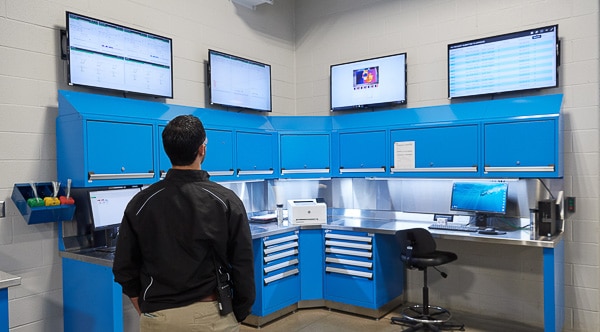
What is a PM Schedule?
A preventive maintenance schedule gives you a framework to organize all the preventive maintenance needs throughout your organization. You need a schedule to ensure essential items aren’t left out or forgotten, as well as to make sure maintenance procedures with multiple steps are performed accurately and completely.
There are two types of preventive maintenance schedules. A fixed PM schedule is one that is fixed in time. For example, on the first Wednesday of the month, a pump is inspected for leaks. This will happen every month on the first Wednesday, regardless of any other tasks to be completed.
The second type of preventive maintenance schedule is called a floating PM schedule. These tasks are defined by previously completed tasks and are triggered by completing the previous work order. If the pump in the above example was on a floating schedule instead of a fixed schedule, it may be inspected four weeks after the last time it was inspected instead of at a certain time each month.
Tips to Start a Preventive Maintenance Schedule
- Establish an equipment list and determine the best PM candidates: To get started, note all the equipment throughout your organization to establish an inventory. Using this list, decide which pieces of equipment you will include in your future preventive maintenance plan.
- Refer to manufacturer recommendations: Look through manufacturer recommendations to establish an effective preventive maintenance schedule. This will help you figure out the necessary tasks and desired frequency of maintenance.
- Start with your heavy hitters: To effectively leverage a preventive maintenance schedule, it is important to begin with your most critical pieces of equipment one step at a time. If you’re unsure how to prioritize your assets, performing an asset criticality analysis can help you narrow down your choices. Once you get started with those critical assets, create long-term plans such as annual schedules.
- Fill in short-term plans: Once you have established long-term plans, you can begin creating weekly plans for your crew. Teams should assign and schedule tasks, and all parts and maintenance resources should be purchased ahead of time to ensure technicians can perform needed maintenance quickly.
Preventive Maintenance Software
Preventive maintenance software, such as eMaint’s CMMS, is key to moving away from reactive maintenance and daily disruptions. With the right program and software, maintenance teams can reduce costs and increase uptime.
Some preventive maintenance examples of real-world client successes include:
- Reducing downtime 85% in six months
- Maintaining a 99.8% uptime rate
- Achieving a 100% compliance on SLAs
Preventive maintenance software is important because it allows maintenance teams to set calendar- and meter-based PM tasks and alerts for every asset. Within the preventive maintenance task record, users add a detailed description that can include important information like a preventive maintenance checklist, task procedures, and guidelines.
Preventive maintenance software also reduces data entry by eliminating the need to create new tasks for every PM schedule. The preventive maintenance software simply associates a PM task with multiple PM schedules.
It also ensures technicians maintain consistency in their processes. Preventive maintenance software enables teams to create a sequence of procedures for every preventive maintenance task. That way, technicians have a step-by-step guide to completing their work. Companies can make certain fields mandatory or require questions to be answered in a specific order, ensuring every step of the needed documentation is completed and helping reduce human errors.
Manufacturers in highly regulated industries also may be subject to audits that require documented proof of maintenance and records of equipment performance. Preventive maintenance software tracks each of these parameters and more. Users can run reports to quickly show highly detailed data, such as when maintenance was performed, what was done, who did it, and more. Tracking this information on paper is cumbersome and prone to employee errors such as misfiling or misplacing. However, preventive maintenance software stores this data on the cloud, backing it up regularly and ensuring your data is always available, even if you’re working off-site.

